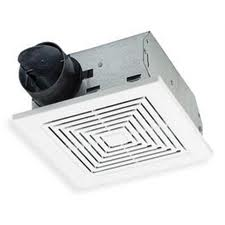 Above the toilet, or somewhere on the bathroom ceiling, is a ventilation fan (or maybe you have a window that you can open). When the fan stops working, there are a couple of things you can do.
Above the toilet, or somewhere on the bathroom ceiling, is a ventilation fan (or maybe you have a window that you can open). When the fan stops working, there are a couple of things you can do.
Pull off the vent cover and check to see that the fan actually has power going to it. Unplug the fan from the outlet in the ceiling, and test the outlet. If it doesn’t have power, you have found your problem. I would check the circuit breakers to see if one has tripped, and check the GFI’s to see if one has tripped. Reset the offending breaker or GFI.
If the outlet does have power, you know the problem is isolated to the fan itself. Does the fan hum or make a low noise? Sometimes the fan blades will become so covered in gunk that they don’t move. You might try cleaning the fan and moving the fan blades by hand to see if that gets it going.
If nothing works, you are likely looking at replacing the fan. The majority are made by Nutone and if you stay with the same brand, you can just slip the new fan into the old bracket without having to replace the bracket.
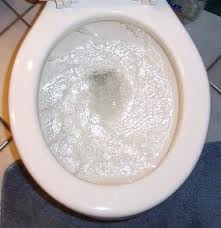 I got an email asking about low water pressure as the toilet was filling. This can happen and it can be easy to fix. If it is the toilet that has low water pressure, in other words it is taking too long to refill, there are a few quick things to do.
I got an email asking about low water pressure as the toilet was filling. This can happen and it can be easy to fix. If it is the toilet that has low water pressure, in other words it is taking too long to refill, there are a few quick things to do.
First, make sure the angle valve to the toilet is fully opened. Follow the water line from the tank to the valve. Turn the handle counter-clockwise until it stops, and the valve should be fully opened. If that doesn’t work and the rest of the house has good pressure, it may be an issue with the angle stop or supply line itself. Remove the supply line from the fill valve at the bottom of the tank and point it in a bucket. Turn the angle valve back on and see if you have strong pressure.
If the pressure is low, I would replace the angle valve and/or the supply line. If the pressure is strong, I would replace the toilet fill valve. Fill valves fail and replacing it will insure you have a good flow of water if the water pressure is good.
Much of the detective work here involves isolating the problem. Like any solution, you have to get to the root problem in order to solve it.
 A poor toilet flush can cause the entire household to use a different toilet. Let’s face it, only the rare few want to be blamed for stopping up a toilet. There are a couple of things to look for. Maybe you have a partial blockage, or maybe there isn’t enough water going down the bowl to clear it.
A poor toilet flush can cause the entire household to use a different toilet. Let’s face it, only the rare few want to be blamed for stopping up a toilet. There are a couple of things to look for. Maybe you have a partial blockage, or maybe there isn’t enough water going down the bowl to clear it.
A partial blockage is frustrating because you don’t know if there is something down there or not. I’ve pulled toys, ink pens, glasses …you get the picture. A good plunging or a snake should clear the trap, but you may have to pull the toilet from the floor and clear it from the bottom. You also may have a blocked vent on the roof.
Also make sure you get a good rush of water down the bowl when you flush the toilet. Start by holding the handle down and seeing if the waste gets flushed away. If it does, you can try to adjust the flapper so it stays up longer to allow more water to flow. You can also replace the flapper with a “dial-a-flush” flapper which allows you to control how long the flapper stays up.
Check under the rim of the toilet to see if there are any blocked holes. When you flush the toilet, water fills the rim and rushes out of these holes. Use a mirror (a cosmetics compact mirror is good here). Hold the mirror low enough so that you can see the holes and determine if there are clogged with scale. If they are, you have found your problem.
Sometimes flushing a toilet can lead to some loud noises. It might be water hammer, but it probably isn’t.
probably isn’t.
Water hammer happens when the water flow is abruptly stopped. This causes a shock wave to travel the length of the piping. If the piping is not secured properly, you can get some loud banging or vibrations. This happens most often with electric valves which shut the water off very quickly…not so much with a toilet, although it can happen. In a toilet, as the float rises in the tank it gradually slows the water until it stops. For this reason it usually isn’t water hammer.
However, the fill valve can make some loud noises that people often conclude is water hammer. If you get noises when you flush the toilet, I would start by replacing the fill valve. This will probably fix the problem. Fill valves can crack and as water pushes through the valve, they can make some weird noises. You might also be getting a small “thud” when the water does stop making you think of water hammer.
Electric valves from a washing machine or even a dishwasher are more likely the culprits of water hammer. If that is the case you can install a water hammer arrestor.
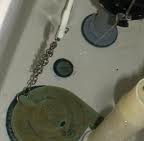 So the toilet is refilling every 20 minutes but nobody is flushing it. You are right to replace the flapper first. This is quick and easy. However, if that doesn’t work, then you need to troubleshoot it.
So the toilet is refilling every 20 minutes but nobody is flushing it. You are right to replace the flapper first. This is quick and easy. However, if that doesn’t work, then you need to troubleshoot it.
Lift the flapper and check the rim of the flush valve where the flapper sits. It should be smooth with no pits or divots in it. If the rim feels rough, this may be allowing water to pass from the tank to the bowl. If this is the problem, you can replace the entire flush valve (which is a bigger job), or buy a flusher-fixer. This is a new flapper assembly with a gel base that sits on the damaged rim. The gel fills any voids and stops water from draining into the bowl.
If everything looks good at this point, check for hairline cracks in the tank around the flush valve. If you have a crack in the tank, you should have water on the floor as well. A small crack around the flush valve may allow water to get by the flush valve and into the bowl.
If you see water on the floor and the toilet refills periodically, look for the source. Generally, you will find the problem at the tank bolts, the fill valve or supply line, or a cracked toilet tank.
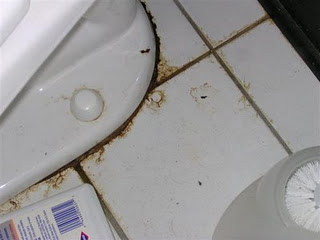 If you see water coming from the base of your toilet, you have a problem. Although many people think that simply caulking around the toilet will fix it, it won’t.
If you see water coming from the base of your toilet, you have a problem. Although many people think that simply caulking around the toilet will fix it, it won’t.
Water (a nice way to say waste) around the base of your toilet where it sits on the floor is an indication that the connection from the toilet to the drain is not secure. In most cases the wax ring has been breached by movement and is no longer molded to the horn of the toilet.
Beginners will just think that they just have to stuff some caulking in between the floor and bottom of the toilet. If it lasts, it’s just going to trap the waste around the perimeter of the toilet’s base. The chances are good though that the waste will continue to seep out.
You will need to replace the wax ring and floor bolts that hold the toilet to the floor. This involves lifting the toilet and scraping up the old ring. Here is an article on replacing a wax ring and toilet bolts.
When you reset the toilet back down, I like to use plaster of paris instead of caulking. Check to make sure that it is allowed, but it has a good open time to work with and when you set the toilet base into it, it fills all of the voids. A wet sponge or rag will wipe away the excess and make for a perfect finish.
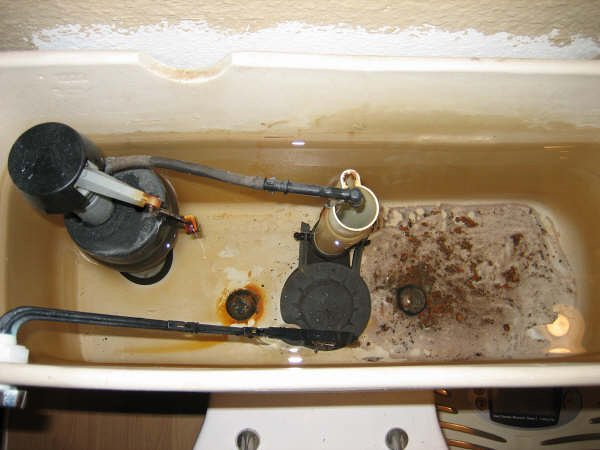 Rusting toilet tank bolts can be surprising. Either you didn’t realize it, or you noticed a drip which caused you to look at them. Sometimes during a quick adjustment, you lift the lid of the toilet tank and you see two giant balls of rust. Underneath all of that rust are the heads of the tank bolts. It’s a good idea to replace them even if they aren’t yet leaking.
Rusting toilet tank bolts can be surprising. Either you didn’t realize it, or you noticed a drip which caused you to look at them. Sometimes during a quick adjustment, you lift the lid of the toilet tank and you see two giant balls of rust. Underneath all of that rust are the heads of the tank bolts. It’s a good idea to replace them even if they aren’t yet leaking.
You may find that when looking underneath the tank (there the bolts are held to the bowl with washers and nuts) that there is a large amount of rust and corrosion here too.
The first step is to remove the old rusted bolts. Usually, you would use a screwdriver and a wrench. The screwdriver is for the bolt head and the wrench for the nut underneath the tank. However, with all of the rust and corrosion, you won’t be able to get it to budge. Sure you can try, but you may even snap the bolt, which is fine.
Try a hacksaw and cut through the bolt. This will allow you to pull the tank off of the bowl but you will be left with the stubs of the bolts sticking out. Tap lightly on the stub and push the bolt head out. You will need to clean up the area where the old bolt head was or you may develop another leak if the new washer doesn’t sit right.
 Rising water in the toilet can make a person very nervous. You flush the toilet and you can tell something is wrong because the water doesn’t go down the bowl, instead it slowly start it’s ascent to the rim of the bowl. This is a tell-tale sign that there is an obstruction in the drain.
Rising water in the toilet can make a person very nervous. You flush the toilet and you can tell something is wrong because the water doesn’t go down the bowl, instead it slowly start it’s ascent to the rim of the bowl. This is a tell-tale sign that there is an obstruction in the drain.
It is usually a partial obstruction, as some water goes down, but not at the rate it should. So instead of having a trapway (the drain hole at the bottom of the toilet) that is 2 ¼”, it may be reduced to a diameter much smaller than that. That is the reason the water starts to rise in the toilet. Since the water can’t go down the drain, it has nowhere to go but rise in the bowl. If you get too nervous and the water looks like it will run over the top of the bowl and onto the floor, you can always turn off the water to the toilet. Look on the wall under the tank and you will see a valve at the wall. Turn this valve clockwise to stop the water. You may have a manibloc system where all of the fixture valves are located in a small cabinet. If this is the case, you won’t have a valve at the wall, rather you will have to go to the manibloc closet and shut off the water with the key provided.
So here is an article on how to unclog a toilet I would go with the toilet plunger first. I’ve had the most amount of success with the plunger.
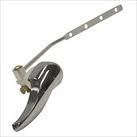 A toilet handle is a simple lever, that when depressed, lifts the flapper and allows water to rush into the toilet bowl. This flushes the waste from the toilet.
A toilet handle is a simple lever, that when depressed, lifts the flapper and allows water to rush into the toilet bowl. This flushes the waste from the toilet.
The only part that you see outside of the tank is of course the handle. But that is only part of the mechanism that causes the flush. If your toilet handle is falling off, it is likely that the nut or threads inside the tank have corroded and the handle is loose and needs replacing.
If you remove the lid to the toilet tank, you will see the workings of the toilet. Look at the handle where it penetrates the tank. You should see a round nut that screws onto some threads on the handle. This nut pulls the toilet handle tight to the outside of the tank. When the nut cracks or corrodes, it can no longer apply the force to hold the handle to the tank.
Buy a new handle and install it. Remove the flapper chain where it connects to the handle and unscrew the nut that holds the handle to the tank (if necessary). The handle will pull right out. Insert the new handle and thread the nut onto the handle to hold it to the tank.
You will probably have to adjust the flapper chain somewhat and give the toilet a few test flushes.
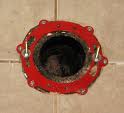 A loose toilet can be fixed by either tightening or replacing the wax ring and bolts underneath the toilet. If the flange that the bolts secure into is broken or cracked, the toilet will still be loose because the broken flange will not be able to hold it in place.
A loose toilet can be fixed by either tightening or replacing the wax ring and bolts underneath the toilet. If the flange that the bolts secure into is broken or cracked, the toilet will still be loose because the broken flange will not be able to hold it in place.
You can replace the flange but that can lead to additional problems. Instead, you can try a reinforcement repair ring. This is a metal ring that lays over the damaged flange. It has multiple holes so that you can align it in multiple ways with the old flange. Basically, you will be placing the new repair ring over the old damaged flange so that the toilet bolts have something to grab onto to hold the toilet to the floor and to the drain.
If the toilet is on the slab, you can use concrete screws to hold the reinforcement repair ring to the old flange and finally the slab. I like tapcon bolts for this, which is probably overkill, but they are very strong. You will need to pre-drill the appropriate sized hole prior to installing the bolt. The repair ring will have many holes for you to choose from so that the bolts won't get in the way of the repair or installation of the toilet. Once you align the ring over the flange you can pre-drill the holes and then install the tapcon screws.
Once the repair ring is installed, you can re-install the toilet using a new wax ring and bolts.